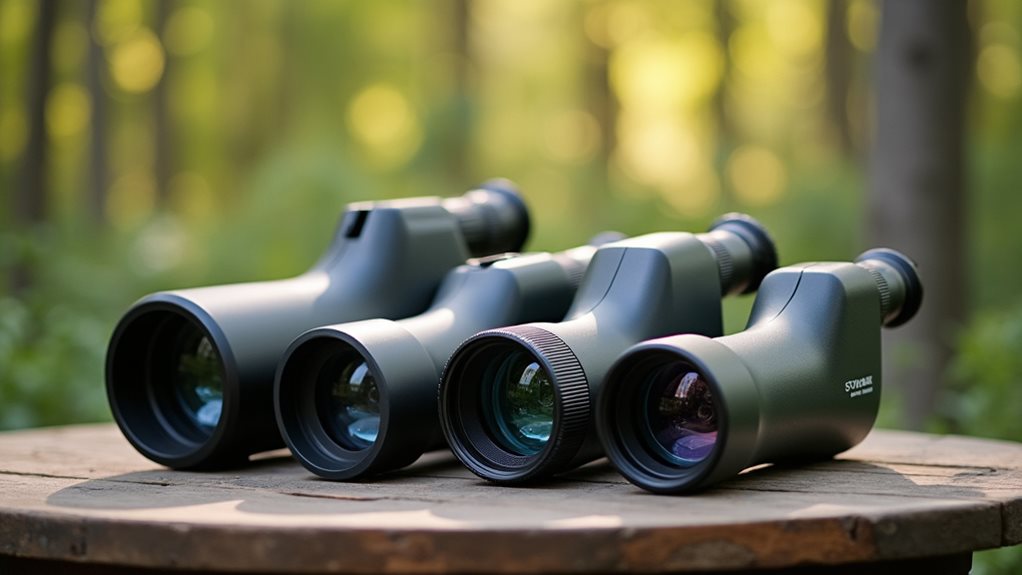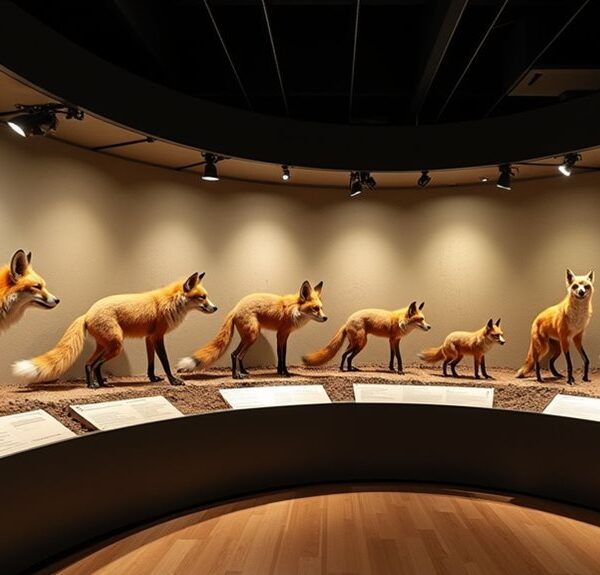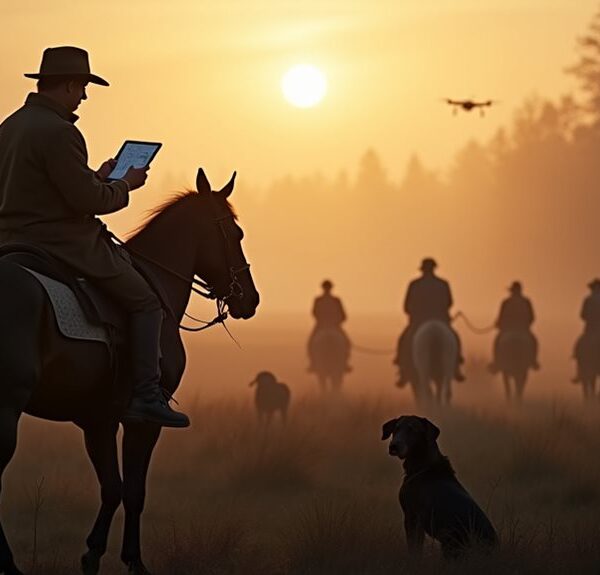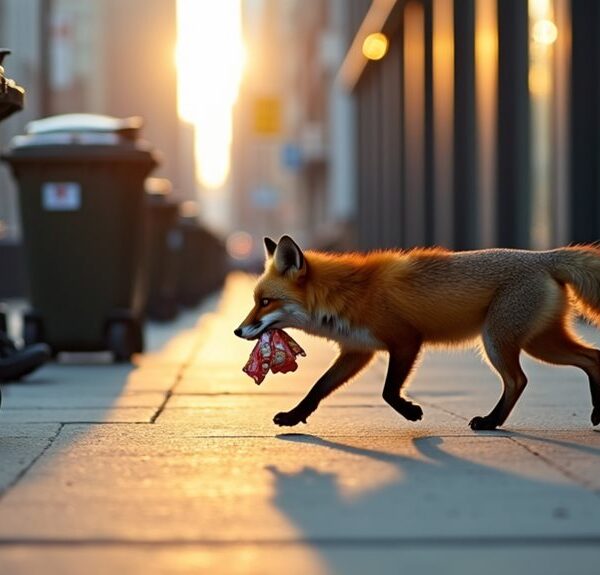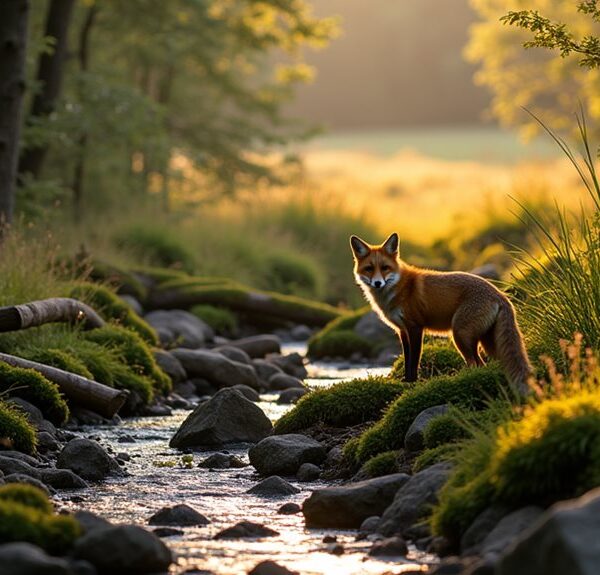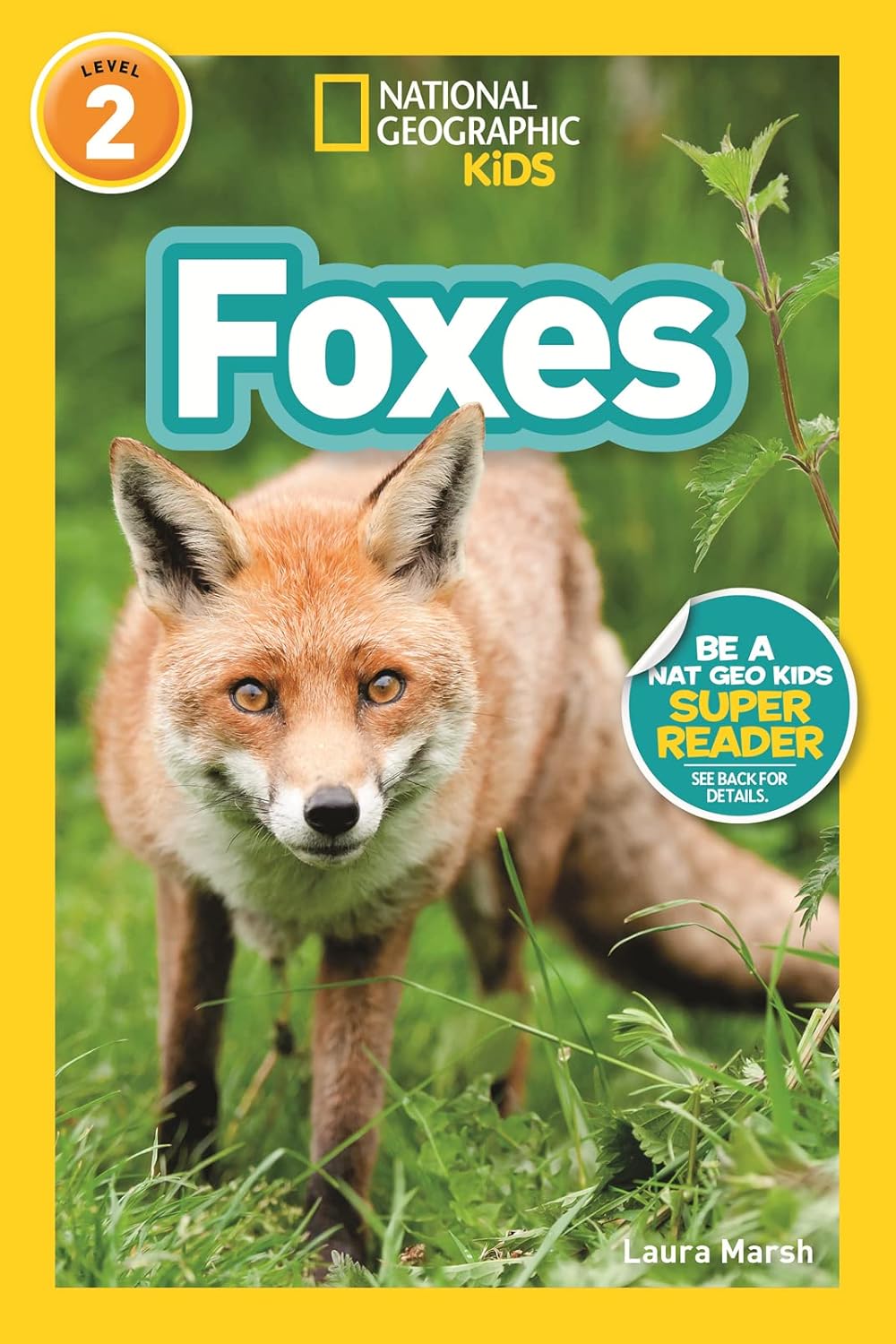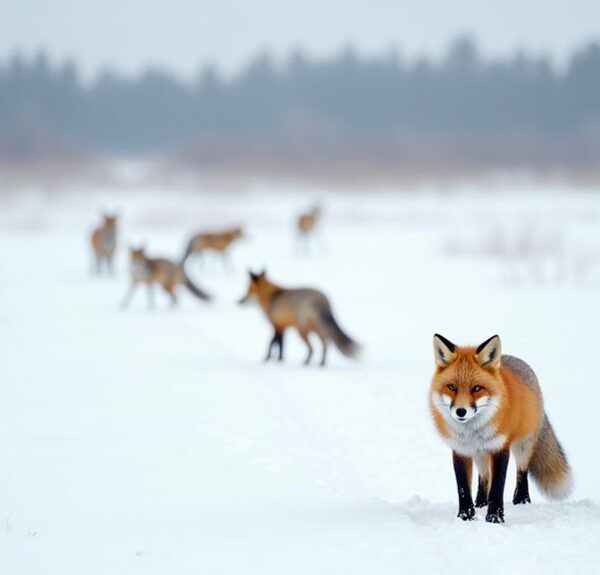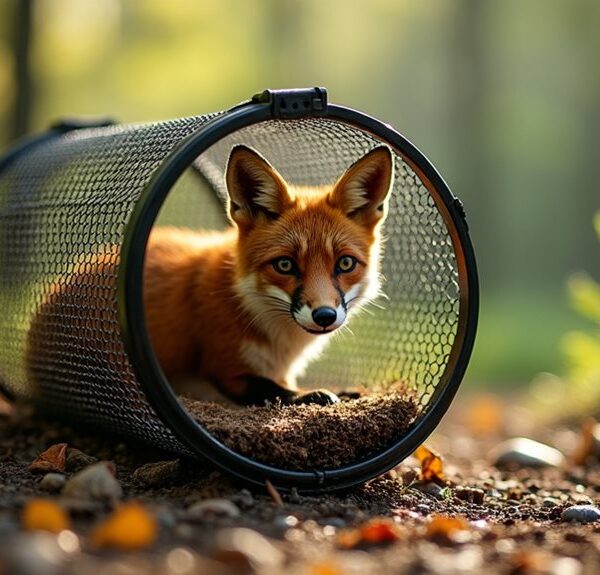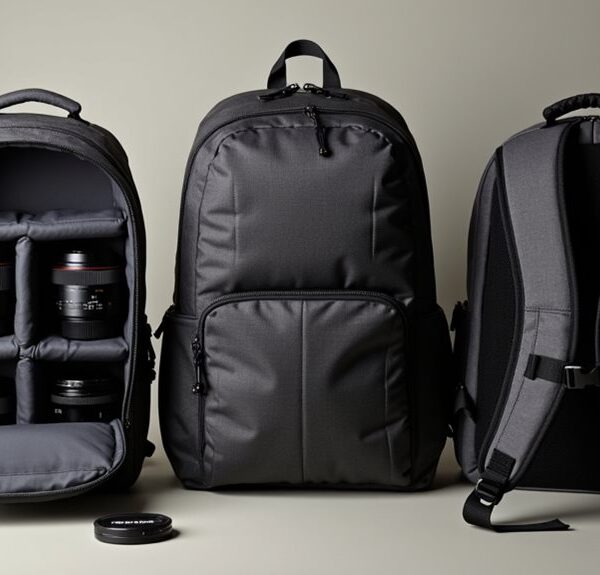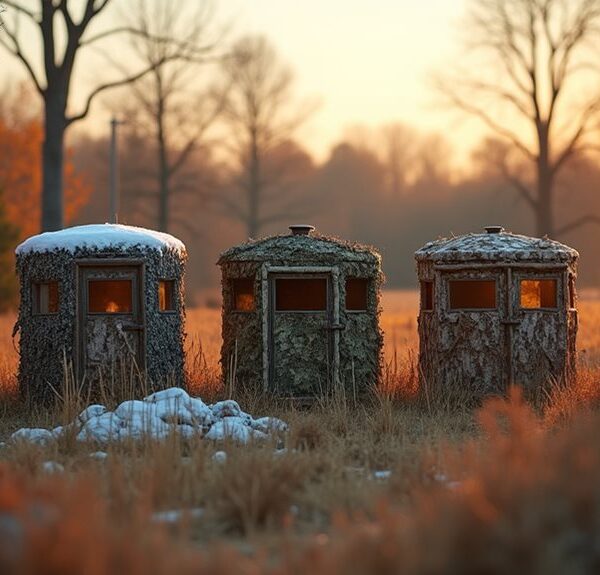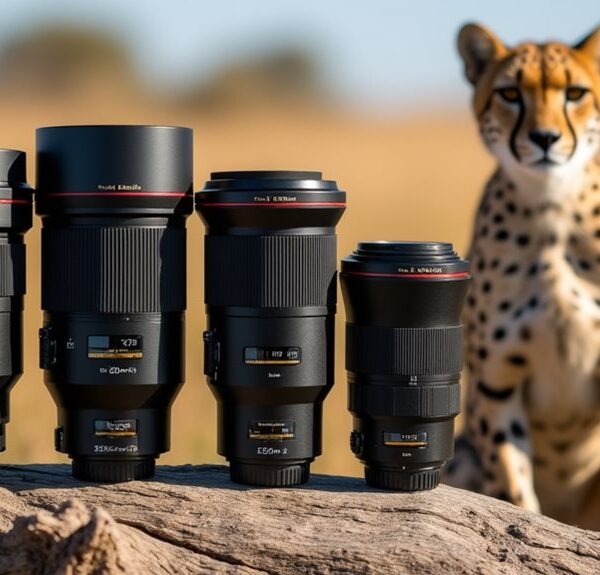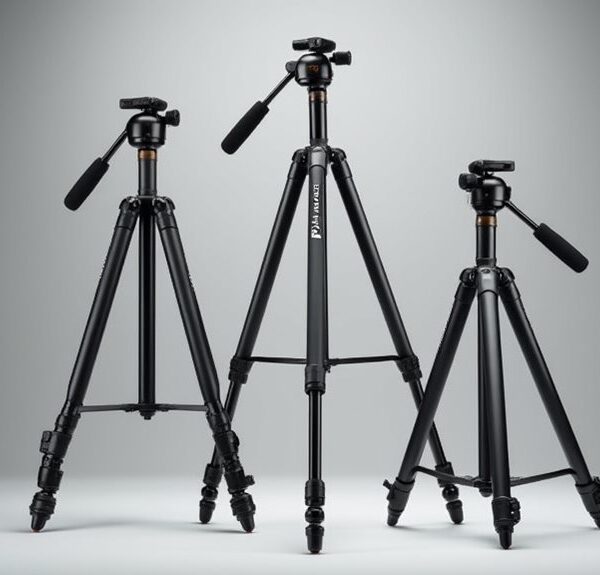Looking for the best spotting scopes? Top picks include the Gosky 20-60×85 with phone adapter, WOSPORTS 25-75×85 with nitrogen-sealed body, Athlon Optics Talos 20-60×80 with K9 prisms, Vortex Diamondback HD with superior low-light performance, and SVBONY SV28 100mm with its large aperture. You’ll want to take into account magnification range, objective lens size, optical coatings, and weatherproofing before making your choice. Below, we’ll break down what makes each scope stand out for different needs.
Contents
- 1 Gosky 20-60×85 Spotting Scope with Tripod and Phone Adapter
- 2 WOSPORTS 25-75×85 Spotting Scope with Tripod for Hunting and Bird Watching
- 3 Athlon Optics Talos 20-60×80 Spotter Scope for Hunting & Bird Watching
- 4 Vortex Optics Diamondback HD Spotting Scopes
- 5 SVBONY SV28 100mm Angled Spotting Scope with Tripod
- 6 Factors to Consider When Choosing Spotting Scopes
- 7 Final Thoughts
Gosky 20-60×85 Spotting Scope with Tripod and Phone Adapter
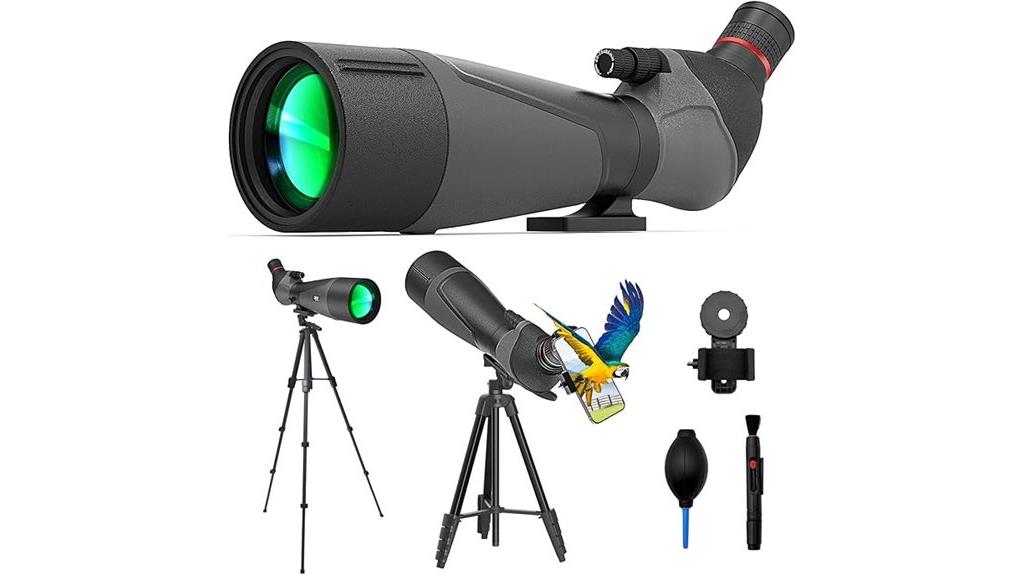
For wildlife enthusiasts and bird watchers who don’t want to miss a single feather detail, the Gosky 20-60×85 Spotting Scope is your perfect companion in the field. You’ll enjoy crystal-clear views through its powerful 20-60x magnification and wide field of view, making it easy to track birds in flight or spot wildlife across vast terrains.
The adjustable tripod extends from 13.3 to 63 inches, so you’re covered whether you’re setting up on uneven ground or need extra height. Don’t worry about sudden rain showers either—this scope’s waterproof design handles the elements with ease. Plus, the included phone adapter lets you capture those breathtaking moments to share with friends later!
Best For: Bird watchers and wildlife enthusiasts seeking professional-quality magnification with the convenience of smartphone photography capabilities.
Pros:
- Exceptional 20-60x magnification with an 85mm objective lens delivers crystal-clear views even in low light conditions
- Highly versatile tripod adjusts from 13.3 to 63 inches with a built-in bubble level for stable viewing on any terrain
- Fully weatherproof design with included carrying case makes it practical for extended outdoor excursions in various conditions
Cons:
- Larger 85mm objective lens creates a heavier setup that might be cumbersome for hikers or long-distance trekkers
- Learning curve may exist for properly aligning and using the phone adapter for photography
- Higher magnification levels (above 40x) may require extremely steady positioning to avoid image shakiness
WOSPORTS 25-75×85 Spotting Scope with Tripod for Hunting and Bird Watching
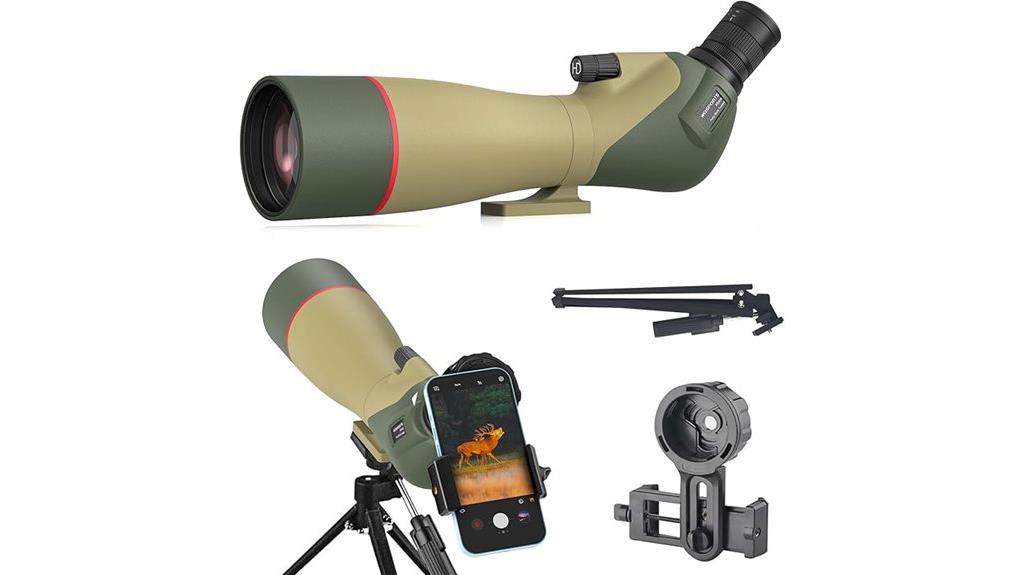
The serious outdoor enthusiast will appreciate how the WOSPORTS 25-75×85 Spotting Scope transforms distant views into breathtaking detail. You’ll enjoy crystal-clear visuals through the 85mm fully multi-coated lens and BAK4 Porro prism, offering an impressive field of view up to 102 ft/1000 yards.
Don’t worry about weather conditions—this scope’s nitrogen-sealed body is waterproof and fog-proof. The twist-up eyecup makes viewing comfortable whether you wear glasses or not. You’ll love the included smartphone adapter that turns your scope into a long-range camera. With the 360° swivel tripod, carry bag, and lens protectors all included, you’re fully equipped for your next adventure.
Best For: Serious hunters and bird watchers seeking high-quality long-range observation with the flexibility to capture images of distant subjects.
Pros:
- Powerful 25-75x magnification with an 85mm lens provides exceptional clarity and detail for identifying distant targets
- Complete kit includes everything needed for immediate use, including a smartphone adapter for photography
- Durable construction with waterproof and fog-proof design ensures reliable performance in various weather conditions
Cons:
- May be bulkier and heavier than more compact spotting scopes, potentially challenging for backpackers or hikers
- Higher magnification levels might be difficult to use without a very stable tripod setup
- Learning curve for optimal focus adjustment and smartphone adapter positioning for newcomers to spotting scopes
Athlon Optics Talos 20-60×80 Spotter Scope for Hunting & Bird Watching
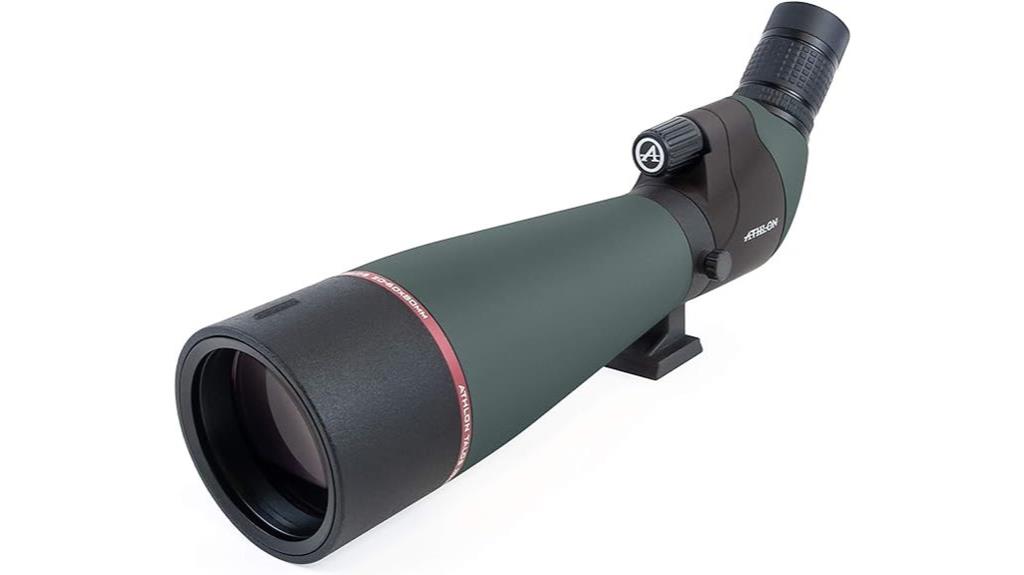
Serious hunters and bird watchers looking for versatile optical equipment will find the Athlon Optics Talos 20-60×80 Spotter Scope an exceptional choice. You’ll appreciate the K9 glass prisms with silver coating that deliver stunningly bright images, even in challenging light conditions.
The scope’s fully multi-coated lenses maximize light transmission, giving you crystal-clear views of your target or that elusive rare bird. Don’t worry about the weather—nitrogen purging and waterproof construction mean you’re covered rain or shine. The rotating ring lets you adjust viewing angles without contorting yourself into uncomfortable positions. It even comes with a cleaning cloth, so you’ll be ready for your next outdoor adventure!
Best For: Serious hunters, target shooters, and bird watchers seeking a high-quality, weather-resistant spotting scope with versatile magnification for extended outdoor observation sessions.
Pros:
- K9 glass prisms with silver coating and fully multi-coated lenses deliver exceptional brightness and clarity even in challenging light conditions
- Nitrogen-purged, waterproof construction ensures reliable performance in harsh weather and prevents internal fogging
- Adjustable 20-60x magnification with comfortable rotating ring design allows for versatile viewing angles without user discomfort
Cons:
- No mention of included protective case or carrying solution for field transport
- Silver coating on prisms, while good, isn’t as premium as dielectric coatings found in higher-end spotting scopes
- Lacks information about eye relief specifications, which is an important consideration for eyeglass wearers
Vortex Optics Diamondback HD Spotting Scopes
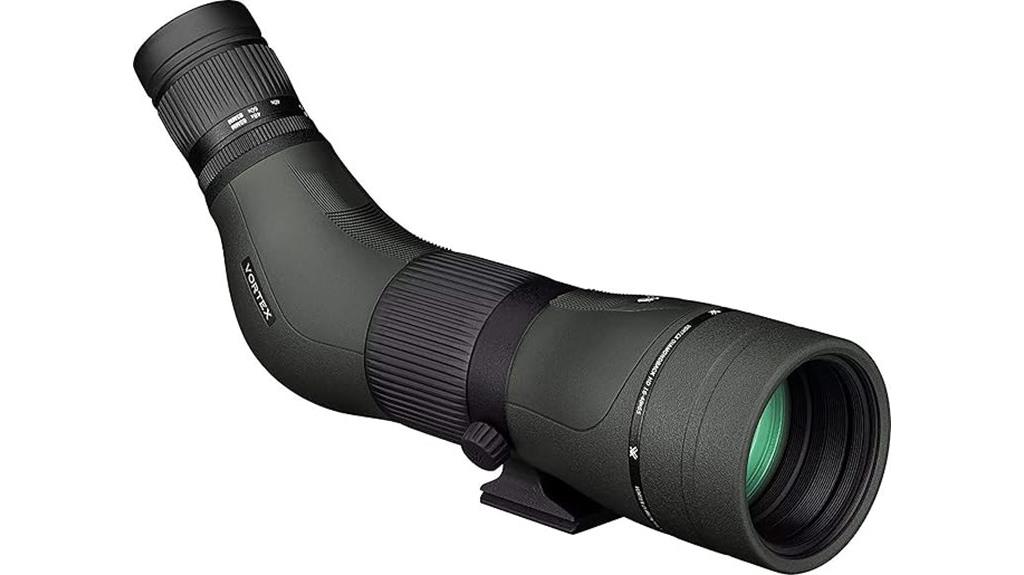
Western hunters seeking exceptional performance in challenging low-light conditions will find their perfect match in the redesigned Vortex Optics Diamondback HD Spotting Scope. You’ll appreciate its sleeker profile that’s easy to pack, while the HD optical system delivers stunning resolution and color fidelity that’ll make you feel like you’re right next to your target.
The built-in helical focus wheel lets you make quick adjustments when that trophy buck suddenly appears. Don’t worry about the elements—this scope is waterproof, fogproof, and backed by Vortex’s legendary lifetime warranty. And with its Arca-Swiss compatibility, you’ll be set up and spotting in seconds!
Best For: Western hunters who need superior optical performance in low-light conditions and want a durable, packable spotting scope with premium features.
Pros:
- Exceptional HD optical system delivers outstanding resolution, color fidelity, and reduced chromatic aberration
- Rugged construction with waterproof/fogproof performance and protective Armortek lens coatings
- Versatile mounting options with Arca-Swiss compatibility and no need for additional adapter plates
Cons:
- Premium price point may be prohibitive for casual or budget-conscious users
- At 3.1 pounds, it may be considered heavy for backpacking over long distances
- Learning curve for optimal use of the helical focus wheel system for those transitioning from traditional focus knobs
SVBONY SV28 100mm Angled Spotting Scope with Tripod
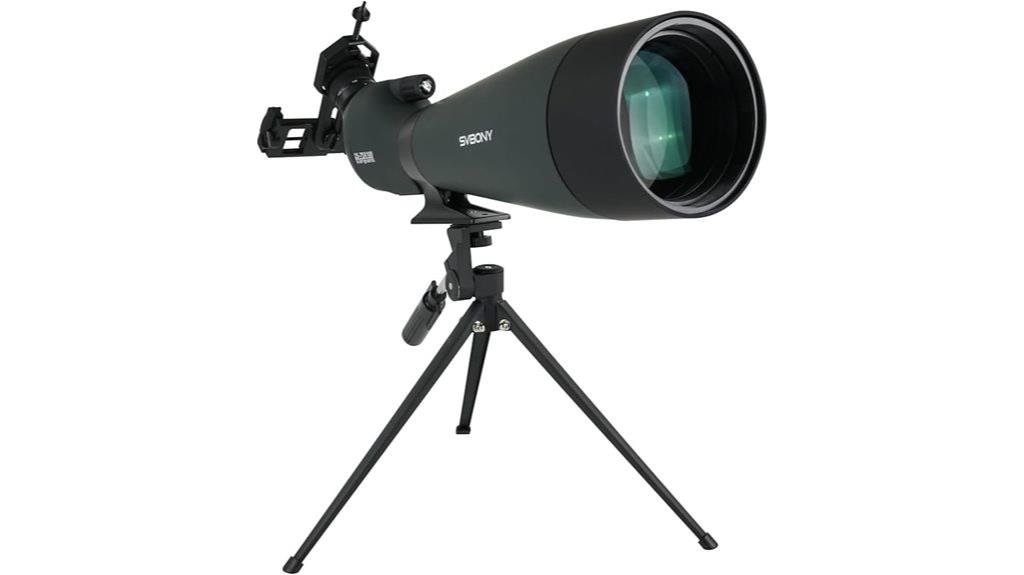
Outdoor enthusiasts seeking crystal-clear views at impressive distances will find their perfect companion in the SVBONY SV28 100mm Angled Spotting Scope. With a powerful 25x-75x magnification range and 100mm aperture, you’ll enjoy brighter images even in challenging light conditions. The angled eyepiece design means you won’t strain your neck during those long wildlife-watching sessions.
You’ll appreciate the complete package that comes with everything you need: a desktop tripod, smartphone adapter, and protective covers for both the lens and eyepiece. The fully multi-coated optics deliver exceptional light transmission, and the twist-up eyecups guarantee you’ll stay comfortable during extended viewing sessions.
Best For: Nature enthusiasts, target shooters, and wildlife observers seeking professional-quality long-range viewing with convenient smartphone compatibility and comfortable extended use.
Pros:
- Impressive 25x-75x magnification with 100mm aperture provides exceptional clarity and brightness even in low-light conditions
- Complete package includes tripod, smartphone adapter, and protective covers, eliminating the need for additional purchases
- Angled eyepiece design with twist-up eyecups reduces neck strain during prolonged observation sessions
Cons:
- At 5.64 pounds, it’s relatively heavy for hiking or backpacking compared to more compact spotting scopes
- Desktop tripod may not provide sufficient height for all viewing situations, potentially requiring a separate full-size tripod
- Newly released product (November 2024) means limited long-term durability feedback from users
Factors to Consider When Choosing Spotting Scopes
Selecting the right spotting scope can feel overwhelming, but you’ll make a better choice if you understand a few key factors. When you’re shopping, pay attention to magnification range, objective lens size, optical coating quality, and weatherproofing features. These crucial elements will determine how well your scope performs in various conditions, whether you’re bird watching on a foggy morning or tracking wildlife across sun-drenched scenery.
Factors to Consider When Choosing Spotting Scopes
Why do some spotting scopes deliver crystal-clear views while others leave you squinting in frustration? It all comes down to the key features you’ll want to prioritize.
First, consider the magnification range—higher power (20-75x) offers detailed views but narrows your field of vision. The objective lens size matters too; larger 100mm lenses will serve you better in dim lighting compared to standard 80mm options. Don’t overlook fully multi-coated optics, which dramatically improve image brightness and clarity.
If you’re an outdoor enthusiast, you’ll need durability features like waterproofing and fog-proofing to withstand nature’s surprises. And don’t forget the accessories! A sturdy tripod, smartphone adapter for sharing those jaw-dropping views, and a reliable carrying case will make your spotting scope experience complete.
Magnification Range
Three key numbers define your spotting scope’s performance, with magnification being perhaps the most crucial. When you’re scanning the horizon for wildlife or tracking a distant target, the right magnification range makes all the difference.
Most spotting scopes offer magnification between 20x and 75x, but don’t automatically assume that higher is better! While those powerful 60x or 75x views reveal incredible detail, they’ll give you a narrower field of view that can make following moving subjects tricky. For wide-open vistas, you’ll appreciate lower magnifications around 20x, while detailed observation demands higher power.
Objective Lens Size
After understanding magnification, you’ll want to contemplate the objective lens size—the second key number in your spotting scope’s specs. Typically ranging from 60mm to 100mm, this measurement dictates how much light enters your scope.
Think of your objective lens as your scope’s light bucket—the larger it is, the brighter your view will be, especially during dawn or dusk observations. An 80mm lens offers that sweet spot between brilliant clarity and not having to lug around something that feels like a small telescope!
While larger lenses (90-100mm) deliver spectacular brightness and wider fields of view for tracking that elusive eagle, they’ll also give your shoulders a workout. For most birders and wildlife enthusiasts, balancing light-gathering capability against portability should guide your decision—your future self will thank you during those long hikes!
Optical Coating Quality
When peering through your spotting scope at a distant hawk, the quality of optical coatings will make the difference between seeing every feather detail or just a blurry silhouette. Fully multi-coated (FMC) lenses aren’t just fancy terminology—they’re your ticket to brighter, crisper images in all lighting conditions.
These premium coatings work by reducing reflections and allowing more light to pass through each lens surface. You’ll notice improved contrast and truer colors, making that distant wildlife pop against the background. Anti-reflective treatments cut down on annoying glare that can ruin your viewing experience, especially at dawn or dusk.
Higher-end scopes often feature silver or dielectric coatings that amplify brightness even further. As a bonus, quality-coated optics typically resist scratches better, meaning your investment will deliver stunning views for years to come.
Weatherproofing Features
The finest optical coatings won’t help you spot that elusive golden eagle if rain droplets cloud your view or interior fog obscures your target. That’s why weatherproofing is crucial for any serious spotting scope.
Look for scopes featuring nitrogen purging, which eliminates internal moisture and prevents fogging when temperatures fluctuate. You’ll appreciate this technology on those chilly dawn outings! Quality scopes also incorporate O-ring seals that keep water and dust at bay, guaranteeing your view remains crystal clear regardless of conditions.
Don’t overlook the protective rubber armor coating – it’s not merely for looks. This tough exterior provides shock absorption if you accidentally bump your scope against a rock, while giving you that confidence-inspiring non-slip grip when your hands are wet. And don’t forget lens caps – these simple accessories protect your investment from scratches and debris.
Field of View
Understanding field of view can dramatically transform your wildlife viewing experience, yet many scope buyers overlook this critical factor. When you’re tracking a fast-moving bird or scanning for distant wildlife, a wider FOV becomes your best friend.
Field of view is typically measured in feet at 1000 yards, with quality scopes ranging from 48 to over 102 feet. Think of it as how much scenery you’ll see through your scope—the wider, the better for tracking movement. You’ll notice that as you crank up the magnification, your field of view narrows, creating a trade-off you’ll need to evaluate.
If you’re constantly following active subjects, prioritize a wider FOV. For stationary observation where details matter more, you might be happy with a narrower view.
Eye Relief Distance
Many spotting scope users discover the importance of eye relief only after hours of uncomfortable viewing sessions. This vital measurement—the distance between your eye and the eyepiece—can make or break your viewing experience, especially if you wear glasses.
For comfortable observation, you’ll want to look for scopes offering 15-20mm of eye relief. This generous distance prevents the dreaded “kidney bean” effect, where dark edges restrict your view. It’s particularly significant when you’re cranking up the magnification for those distant wildlife shots.
Most quality scopes now come with adjustable eyecups that you can twist or fold to customize your viewing position. Don’t overlook this feature when shopping—your eyes will thank you after a full day of birding or wildlife spotting!
Final Thoughts
You’ve now explored our top five spotting scopes, each offering unique features for your outdoor adventures. Whether you’re tracking wildlife or stargazing, remember to take into account magnification, lens quality, and durability when making your choice. Don’t forget about the importance of a stable tripod too! With the right spotting scope in hand, you’ll catch details you never noticed before. Happy spotting, and enjoy those breathtaking views!

